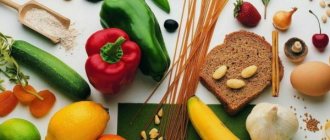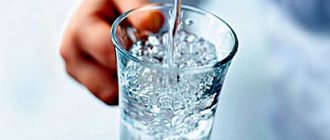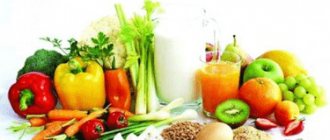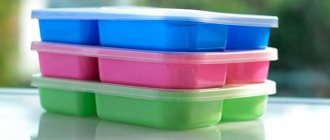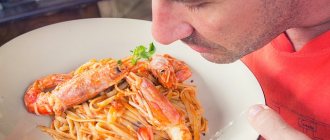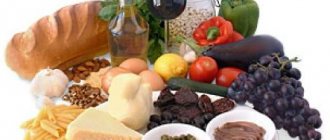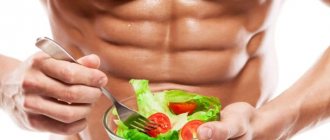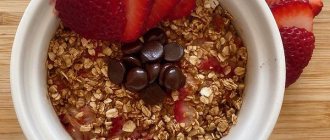- Proper nutrition: principles
- How not to gain weight
- The importance of breakfast
- How to improve your health through healthy eating
- Physical activity and proper nutrition
- Drinking regime
A healthy, balanced diet helps a person at any age to stay healthy and maintain optimal body weight.
Surprisingly, following the principles of proper nutrition allows you to get rid of health problems; healthy food is a kind of “vaccination” against various ailments. It's never too late to change something in your life, this also applies to a balanced diet. To prevent the body from experiencing stress, it is important that the transition from the usual diet to a balanced diet is gradual. In addition, it is important for the body to absorb the nutrients supplied with food by fully observing a few simple rules of proper nutrition.
Healthy eating for the whole family: choosing healthy foods and creating a menu for every day
We all think about our diet sooner or later: problems with weight, skin, and health in general force us to open our refrigerator and skeptically examine its contents.
We ask ourselves the questions “what to exclude from the diet?” and “how can I start eating right?”, we are looking for our way to a healthy and beautiful body. Meanwhile, healthy and proper nutrition is not a strict, exhausting diet, not a mockery of the body and not depriving it of its joys, it is just a series of rules, if followed, you can radically change yourself, acquire new useful habits, a beautiful figure and significantly prolong your life.
Our body is a reflection of what we eat
It's no secret that obesity has become a huge problem for modern people - we move less, consume large amounts of fatty foods, high-calorie sauces, and sweets. There are endless temptations everywhere, and manufacturers compete to see who will offer the next super product that no consumer can resist. The result of this race can be observed on the streets of any metropolis - according to statistics, almost every second resident of developed countries is overweight. Obesity, unfortunately, leads to problems not only in aesthetics and self-esteem, but also to serious consequences for the body: the risk of many diseases is directly proportional to the amount of excess weight. Diabetes, problems with the heart, gastrointestinal tract, and reproductive function are only a small part of the possible diseases that arise when the diet is not followed.
The good news is that in recent years, taking care of your body has begun to become fashionable: more and more calls to exercise are being made by the state and public organizations, organic and dietary products are appearing on store shelves, and advice on how to eat healthy is being disseminated in the press. .
The basics of healthy eating, or how to eat healthy
When creating a healthy eating menu, you should remember several general rules: firstly, you need to eat often and in small portions. It’s most convenient to get yourself a small plate that can hold a handful-sized portion. No need to be afraid of hunger! A healthy diet involves 5-6 meals per day. It is also good to accustom yourself to eat at the same time - this will stabilize the functioning of the stomach and will promote weight loss.
The second important rule is to remember about calories. There is no need to scrupulously calculate them throughout your life every time you eat; just watch your diet for a week or two, and the habit of automatically “estimating” the calorie content of food will appear by itself. Everyone has their own calorie intake; you can find it out, for example, by using a special calculator that is easy to find on the Internet. For example, a 30-year-old woman weighing 70 kg with a height of 170 cm and little physical activity needs about 2000 kcal per day. To lose weight, you need to consume 80% of calories from the norm, that is, in our example, about 1600 kcal per day. Additionally, there is no point in cutting down your diet - the body will simply slow down its metabolism, and such a diet does more harm than good.
Rule three - we maintain a balance between “income” and “expenses”, that is, the energy that is spent by the body on basic metabolism, work, sports, and calorie intake. Food includes four main components: proteins, fats, carbohydrates and dietary fiber - all of which are necessary for our body. The only question is which of them (fats and carbohydrates are different), in what quantities and proportions to consume. Approximate recommended values are 60 g fat, 75 g protein, 250 g carbohydrates and 30 g fiber. The fourth rule is to drink water. Often we don’t want to eat, our body simply mistakes a lack of fluid for hunger and forces us to eat something that we really don’t need. One and a half or more liters of clean drinking water will help get rid of pseudo-hunger, make the skin more elastic, improve the general condition of the body, and speed up the metabolic process.
And the fifth rule is to choose products wisely. Read labels, composition and calorie content of products, exclude fast food, mayonnaise sauces, products with chemical additives, preservatives, and dyes from your diet. You must know what you eat, and then the path to beauty and health will become quick and enjoyable.
Healthy food
We will try to answer the age-old question “what to eat to lose weight?” The main thing when creating a menu for a healthy diet is maintaining a balance between expenses and consumed products.
For drinks, it is recommended to consume mineral water, chicory, smoothies, green tea and natural freshly squeezed juices, preferably vegetable ones.
Healthy products should not contain preservatives, artificial colors, or palm oil. It is better to limit pickles - you can treat yourself to them from time to time, but you should not get carried away.
If you have a problem with excess weight, then you should give up sugar altogether, even if you have a sweet tooth and cannot live without a cup of sweet coffee in the morning - sweeteners will solve this problem. Don't be afraid of them; high-quality natural-based substitutes are harmless, contain virtually no calories and taste good.
Strictly prohibited!
Tips for proper nutrition
The transition to a balanced healthy diet will not be a burden if you follow simple recommendations.
First of all, don't starve yourself. If you feel discomfort, eat an apple, some nuts, dried fruits or muesli.
Secondly, drink a lot and choose healthy drinks. Chicory is good for weight loss - it suppresses hunger due to the large amount of fiber in its composition and has a beneficial effect on the body. Green tea is also beneficial, especially with ginger.
Recipes
For novice cooks, recipes for proper nutrition will be useful. Healthy food is even easier to prepare than regular food. Let's look at a few recipes for morning meals, lunch and dinner.
Cottage cheese casserole
Ingredients:
- Cottage cheese – 280 g.
- Semolina – 3 tbsp.
- Egg – 2 pcs.
- Milk – 4 tbsp.
- Sugar – 1 tbsp.
- Salt – 1 pinch
- Berries - to taste.
- Vegetable oil – 1 tsp.
Preparation:
- Beat eggs with salt and sugar.
- Pour warm milk over semolina for 10 minutes.
- Grind the cottage cheese through a sieve, add eggs and semolina.
- Add clean berries and stir until smooth.
- Grease the pan with butter and sprinkle with semolina. Lay out the curd mixture. Bake for 45 minutes at 180°C. Cottage cheese casserole is one of the healthy dishes included in a proper diet for weight loss.
Pumpkin and apple pancakes
Ingredients:
- Pumpkin – 100 g.
- Apple – 1 pc.
- Egg – 1 pc.
- Rice flour – 50 g.
- Milk – 3 tbsp.
- Semolina – 50 g.
- Sugar – 1 tbsp.
- Baking powder – 1 tbsp.
- Vanillin - to taste
Preparation:
- Mix eggs with milk and beat. Add salt and sugar.
- Grind the pumpkin on a fine grater and squeeze out the juice.
- Add pumpkin, semolina and flour to the egg mixture. Leave for 10 minutes.
- Peel the apple and cut into cubes.
- Add apples to the dough and stir until smooth.
- Fry the pancakes until golden brown on each side.
Zucchini soup
Ingredients:
- Zucchini – 1 pc.
- Onions – 1 pc.
- Carrots – 1 pc.
- Water – 200 ml.
- Broth – 1 tbsp.
- Garlic – 2 teeth.
- Sour cream – 1 tbsp.
- Dill – 1 tbsp.
- Salt - to taste.
Preparation:
- Peel all vegetables and rinse with water.
- Cut the zucchini into large cubes. Chop carrots and onions into medium pieces.
- Boil vegetables in water until tender.
- Grind the vegetables in a blender with the addition of broth.
- Transfer the vegetable mixture to a saucepan, add herbs and garlic. Serve the soup with sour cream.
Baked pike perch with oranges
Ingredients:
- Pike perch – 1 pc.
- Orange – 1 pc.
- Yogurt – 3 tbsp.
- Olive oil – 1 tbsp.
- Salt - to taste.
Preparation:
- Clean and gut the fish, rinse well with water.
- Squeeze the juice from the orange and remove the zest.
- Make a marinade from juice, salt, oil, yogurt and zest.
- Cover the pike perch with marinade and wrap in foil.
- Bake for 35 minutes at 190°C.
As it turned out, proper nutrition for weight loss at home is easy to follow and meals for PP are not so tedious to prepare. In addition to the main dishes, prepare healthy cocktails. They satisfy hunger well. Sometimes replace dinner with these drinks.
How to reduce your appetite
We figured out how to switch to simple proper nutrition for weight loss
To effectively lose extra pounds, it is very important to monitor your appetite. If you constantly want to eat, then you can eliminate this problem with the help of special products and psychological tricks
Foods that nourish the body well:
- protein;
- cellulose;
- nuts;
- coffee;
- water;
- ginger;
- fish.
You can increase your feeling of satiety using psychological methods:
- Use small plates and cutlery. Large dishes lead to larger portions.
- Sport lowers the level of hunger hormones in the blood.
- Normalize your sleep to reduce your appetite.
- Stress leads to frequent snacking, so try to avoid it.
- Chew your food slowly and eat in silence.
- Finish your meal at the first sign of satiety.
The goals and objectives of healthy eating are defined
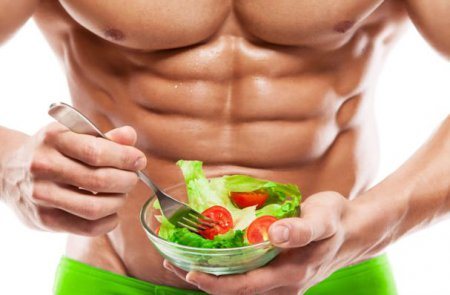
For well-being and good health, it is very important to eat right. Healthy eating and a properly composed diet will not only solve the problem of excess weight, but also improve the health of the entire body, fill it with energy and boost immunity. This is precisely the goal and purpose of healthy eating.
A person receives a supply of vital vitamins, microelements, proteins, fats and carbohydrates from food. Therefore, our well-being directly depends on its quality. Frequent colds, loss of strength, depression, decreased performance - these can all be consequences of poor nutrition. Even such small and seemingly harmless habits as snacking on sweets, overeating at night, and indulging in fatty and fried foods can greatly worsen your health, add excess weight and disrupt the intestinal microflora, which means weakening the immune system and the body’s ability to resist infections.
Used/Used Consumption Standards
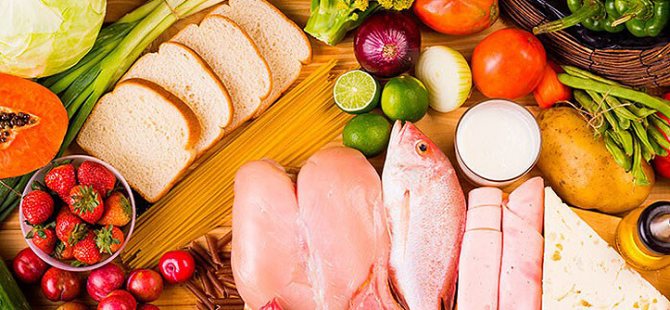
How much of these components does the body need to supply? Scientists have long found an answer to this question. The principles of proper nutrition they described fix the protein intake rate for the average healthy person in the range of 1.3 – 1.5 grams of protein per kilogram of body weight. Fats should also be about 1.3 – 1.5 grams/kg, and carbohydrates – 5 grams/kg. What is the consumption rate for bodybuilders? The numbers will be as follows: proteins - 2 grams per kilogram of weight (no less), carbohydrates 6 - 7 grams, fats 1 - 1.5 grams. In general, the approach in this case is simple. As in the case of calorie content, as we wrote about above.
General recommendations, as a rule, are adjusted for each individual, therefore, if during the process of gaining weight these proportions are small for you, you can slightly increase the amount of protein to 2.5 - 3 grams per kilogram of weight, carbohydrates 7.5 - 8 grams per kilogram , fats can be left at 1.5 grams. When losing weight, the amount of protein can be left at 2 grams per kilogram of weight, carbohydrates can be reduced to 3 - 4 grams, fats to 0.5 - 1 grams / kg. In any case, here, as in training, you need to experiment a lot and select these numbers specifically for yourself.
The goals and objectives of healthy eating are defined
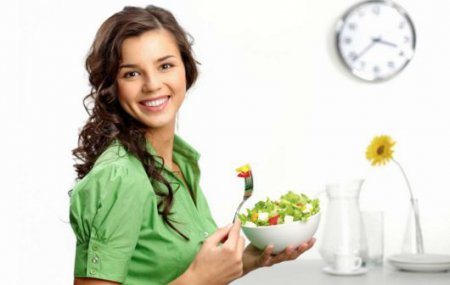
The main goal of a healthy diet is to maintain optimal weight and provide the human body with the necessary nutrients for its growth, development and high-quality mental and physical activity. This is why it is so important to adhere to the principles of a balanced, healthy diet.
The objectives of healthy eating are varied, but all of them are aimed at achieving its main goal - maintaining human health. Nutritionists call the following tasks of healthy eating and developing a healthy diet:
• achieving and maintaining normal weight, depending on body type; • providing the necessary amount of calories for active life; • maintaining balanced hormonal levels and blood sugar levels; • meeting the body's needs for vitamins, minerals and trace elements; • maintaining normal intestinal microflora; • maintaining proper functioning of the digestive and excretory systems; • neutralization or reduction of the harmful effects of the environment on human health.
Diet calorie calculations
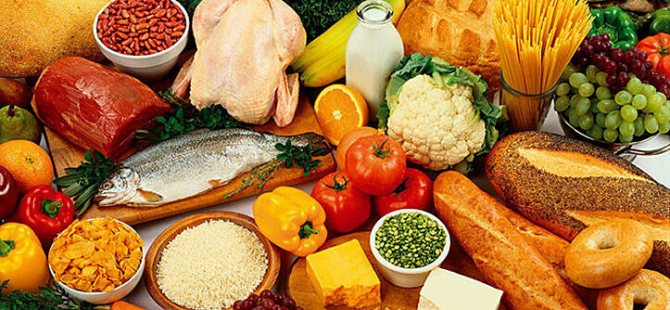
So, knowing the initial consumption of proteins, fats and carbohydrates per kilogram of weight, we can perform the appropriate calculations for three cases: weight retention, weight gain and weight loss. We return again to the pressing issue of calories. To carry out empirical calculations, we will again select an average person weighing 70 kg and calculate the calorie content of his diet. Let's take the average numbers for proteins, fats and carbohydrates. The average protein value is in the range between 1.3 – 1.5 = 1.4 grams per 1 kg of weight. The arithmetic mean for fats is also = 1.4. We leave carbohydrates at = 5 grams/kg.
70 kg * 1.4 = 98 g. squirrel
70 kg * 1.4 = 98 g. fat
70 kg * 5 = 350 gr. carbohydrates
As you know, 1 gram of protein equals 4 calories, 1 gram of fat = 9 calories, 1 gram of carbohydrates = 4 calories. We convert the resulting grams into calories and get: 98*4 + 98*9 + 350*4 = 392 + 882 + 1400 = 2674 calories. In this simple way, we have obtained the daily calorie intake for the average person trying to keep their weight at the same level.
Now let’s calculate what the daily calorie intake should be for a person who works out in the gym and aims to gain muscle mass. Such a goal increases the need for appropriate nutritional components, which means we take increased indicators that cover the body’s needs during active physical activity.
70 kg * 2 = 140 gr. squirrel
70 kg * 1.5 = 105 g. fat
70 kg * 7 = 490 g. carbohydrates
140*4 + 105*9 + 490*4 = 560 + 945 + 1960 = 3465 calories
Now, for fun, let’s imagine that you weigh 70 kg and are trying to lose excess weight. Let's calculate the calorie content of the daily diet, according to the maximum permissible underestimated nutrient intake, in accordance with the goal of reducing body weight.
70 kg * 2 = 140 gr. squirrel
70 kg * 0.5 = 35 g. fat
70 kg * 3 = 210 g. carbohydrates
140*4 + 35*9 + 210*4 = 560 + 315 + 840 = 1715 calories
So, in some ideal case, the daily caloric intake for a person who is losing weight should be 1715 calories. For a person who strives neither to gain nor lose, but simply to maintain weight - 2674 calories. For someone actively engaged in bodybuilding and seeking to build muscle mass, the figure will be 3465 calories.
Data with calculations of the average calorie intake for weight loss, maintenance and weight gain are given in the table below. It’s worth mentioning right away that the data in the fields “less than 50” and “more than 100” are given for the sake of completeness, however, in the author’s opinion, there is a logical explanation why if you weigh less than 50 kg you should strive to lose it, or gain weight of more than 100 kg - No.
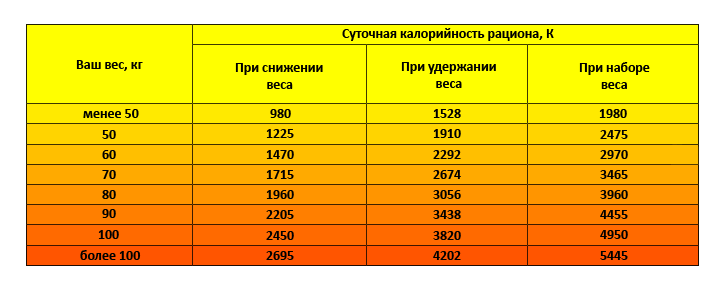
Why should these indicators be considered average or relative? Because we are all different, each body is different, metabolism and metabolism are also different, respectively, and the need for calories will be different for everyone. The numbers will also be different depending on the level of physical activity and, accordingly, energy consumption. As a conclusion, again the most popular rule, which is universal for everyone, both in training and in nutrition - experiment, search, try and find the amount of calories that will give you the desired result.
Goals and objectives of healthy eating video defined
When creating a diet, nutritionists advise paying special attention to the meal schedule. They call frequent split meals the optimal way, in which they eat often, but little by little. An additional advantage for facilitating the functioning of the digestive system will be separate meals, when the body saves energy and receives maximum nutrients from food due to the fact that poorly compatible and difficult to digest foods are distributed among different meals.
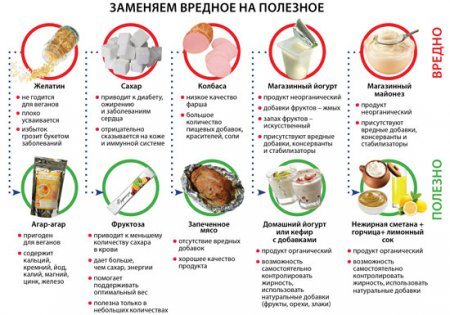
proper nutrition
Equally important to a healthy diet is how food is prepared. After all, even the most healthy foods can be turned into harmful ones by overcooking them or adding too much oil or fat. Stewing and steaming are considered healthy cooking methods, while frying and smoking are considered the most harmful.
The formation of good eating habits should begin at an early age and be maintained throughout life.
Goals and objectives of proper nutrition
The end of winter and the beginning of spring is the time when everyone talks about depression, lack of sun and vitamins.
But if you choose the right foods and combine them well, this problem can be avoided. The goals and objectives of proper nutrition are to charge us with energy so that we do not feel a loss of strength even in the most uncomfortable season. Save usefulness
Some of our eating habits bring us down at any time. For example, constant snacking, excess sweet, salty, fatty foods will not add to your health and will not raise your energy level. Despite the fact that we are constantly short of time, we always need to find time to review our diet. After all, some substances are involved in cellular metabolism, others maintain muscle tone, and others are necessary for normal brain function.
Everyone knows that during heat treatment, foods lose some of their beneficial substances. Of course, the question arises: is it worth switching to a raw food diet? Experts are ambiguous in their advice. Since raw food loads the stomach and requires a lot of effort from us to digest. Best option: Try to find a balance between raw and cooked foods in your daily menu. Try to eat vegetables and fruits that are in season. This is one of the main principles of proper nutrition. Not only will they be fresher, but they will also give you more nutrients. You should still start your meal with fresh foods, as the enzymes in them will help further digestion of food.
An important task of proper nutrition is to learn how to cook competently. The ideal option is when the vegetables are cooked on the outside, but raw on the inside. For example, by steaming, or simmering in the oven at a maximum temperature of 80 degrees, or other mild methods of heat treatment, you can preserve the beneficial properties. To avoid overheating food, remove it from the refrigerator an hour before eating before eating. During this time, it will have time to warm up to room temperature. Some spices, such as ginger, will also help give strength and vigor.
Little by little, but often
It is believed that it is healthy to eat three times a day. But nutritionists have recently argued that this is not enough. To save energy, you need to allow yourself snacks in the form of fruit or a sandwich of whole grain bread and low-fat cheese. The breaks between main meals and snacks should be at least two hours, but no more. Breakfast and dinner may be lighter. But lunch should be high in calories, because it is in the middle of the day that we spend the most energy.
Expert advice from a nutritionist - what you need to know?
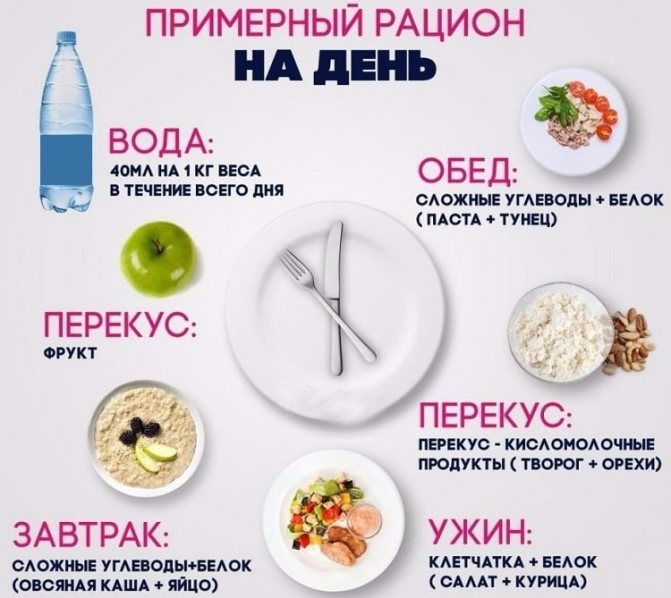
First of all, before breakfast, be sure to drink a glass or two of clean water. Warm. Negatively charged is best. Why drink negatively charged water and how to make it yourself correctly, we explain in detail and learn how to do it at the First Wellness School courses.
In addition, you need to have breakfast within the first hour after waking up. Moreover, this should be a full breakfast, and not a cup of coffee.
Breakfast's calorie content is approximately 25% of the daily calorie intake.
Eating breakfast later than 1 hour after waking up, as well as coffee on an empty stomach, triggers increased production of the stress hormone cortisol, which in turn leads to excess weight gain in people prone to obesity.
In order to balance your diet correctly, use the step-by-step guide for calculating calories and proper weight loss in the book - Food Diary: “The Path to an Ideal Figure” in .pdf format

Buy a book from a nutritionist-nutritionist
“Food Diary: The Path to an Ideal Figure!” for 999 rubles 299 rubles.
Buy a book for 299 rubles:
*To buy the book, click the "Submit" button. The book will be sent to you by email, which you indicate when paying.
Dinner
2. For lunch we eat complex carbohydrates and protein. This will allow you to saturate your body for a long time and not overeat at dinner.
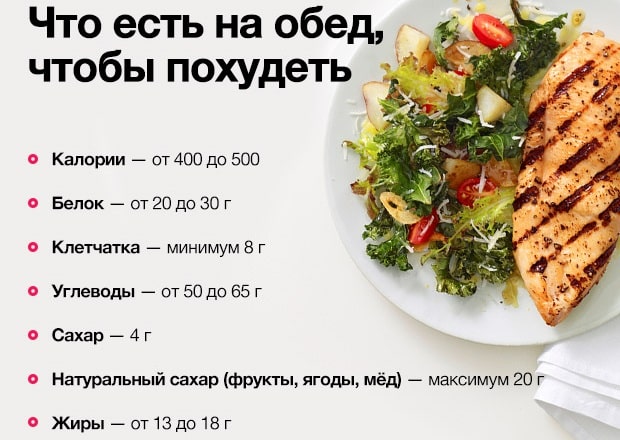
Lunch should be 35% of the total daily calorie intake.
Dinner
3. The ideal dinner for weight loss should include protein foods and foods rich in fiber (vegetables). Protein is a tool for building our muscles and bones, and fiber is a product that is not processed into fat cells.
You should have dinner about 3 hours before bedtime. Not earlier, otherwise you will go to bed hungry. And not later, otherwise the food will not have time to be absorbed.
An important rule: not eating after 18.00 only works if you go to bed at 21.00. For each person, the time of the last meal will be individual and depends on his daily schedule.
If you go to bed from 21:00 to 22:00, then you should have dinner no later than 19:00.
If you go to bed late, after 24:00, then you can eat before 21:00.
Dinner should be 20-25% of the daily calorie intake.
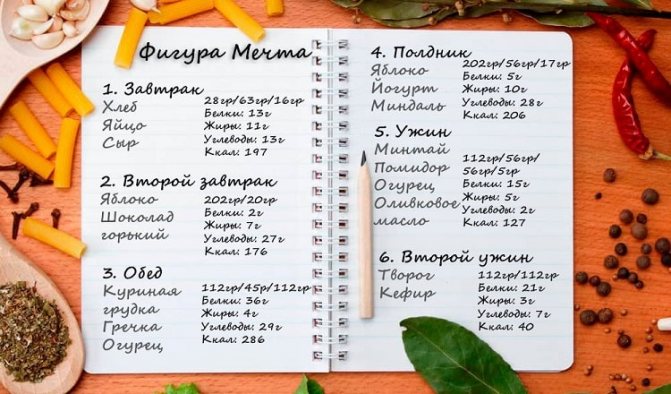
Snacks
4. It is best to leave fruits for second breakfast and eat them separately from the main meal. Fruits cannot be combined with anything. This is a separate dish. Otherwise, eating fruit after the main meal, especially after a meat dish, causes fermentation and rotting processes to occur in the intestines. Do you need it?
If you want to eat fruit during the day, it is better to do this 20-30 minutes before the main meal.
Before bedtime
5. If you have a strong feeling of hunger late in the evening, I recommend that you always have Acidophilus in the refrigerator; this is a fermented milk product, but unlike yogurt and kefir, the acidophilus bacillus settles in the intestines for a long time and is its beneficial microflora.
Acidophilus is much healthier than kefir and yoghurt, also because it contains all the vitamins and minerals we need for health.
Make yourself this cocktail of acidophilus and greens.
Cocktail
Required ingredients:
1. Acidophilus - 350 ml, just look at the dates, the store likes to supply perishable products by date.
It is best if it is a fresh, recently prepared drink.
2. Dill, base 30 grams.
3. Parsley or cilantro - 10-20 grams to taste. If you choose cilantro, it is spicier, so you can add just a little bit.
In general, when you make this drink 1-2-3 times, you will understand how much greenery you want to add.
Preparation:
1. Wash the greens and add to the blender bowl.
2. Pour in Acidophilus.
3. Whisk.
The cocktail is ready!
This drink will help the intestines function properly; drinking it every day will not have any problems. It also helps saturate and refresh!
Long-term plan for the “Healthy Eating” project
Dinara Gazatulina
Long-term plan for the “Healthy Eating” project
The goal of the project : to form in children clear ideas about products that benefit the body, about the organization of proper healthy nutrition .
Project objectives :
• Expand children's knowledge about healthy and unhealthy foods , promote and advertise only healthy foods ;
• To develop children's interest and willingness to follow the rules of rational and healthy nutrition ;
• Contribute to the development of children's creative abilities, the ability to work together, coordinating their actions.
Specially organized activities
“Why do we eat?”
Goal: To expand children's knowledge about the benefits of food for our body as a whole.
“What does our food consist of (What does our food consist of)
» Purpose: To give an idea of the vitamins contained in
food . Definition of the word "Vitamins"
Drawing "These healthy fruits"
— Goal: To consolidate knowledge about the vitamins contained in fruits.
“What food should you eat to be healthy ”
Goal: To generalize knowledge about
healthy eating .
Drawing up a table setting diagram Purpose: To consolidate knowledge about the arrangement of cutlery and dishes on the table.
Remember proverbs and sayings about food and table culture. Purpose: To help understand the meaning of these proverbs and sayings.
Making a collage from labels, wrappers, packaging of healthy and unhealthy nutrition .
Making and guessing riddles about food . Goal: To develop logical thinking.
Creation of the album “Vitamins”
Goal: To promote
Development of children's horizons.
Introduction to the food “What I ate healthy and unhealthy in a day”
Goal: Application of acquired knowledge in practice,
promote a caring attitude towards one's health .
"Vitamin crossword"
goal: To consolidate knowledge about healthy
foods .
Making Carrot Salad
S/r game “Grocery Store”
Goal: Develop the ability to independently distribute roles, develop friendliness.
D/i “Create a menu”
Goal: To be able to justify why it is advisable to eat these foods for breakfast, lunch, afternoon snack, dinner...
D/i “Beneficial and Harmful”
Goal: To be able to correlate
food .
Working with parents
Poll “What do you think is “ healthy eating ?”
»
Purpose: To gain an understanding of parents' knowledge on this topic.
Consultation for parents “Basic principles of healthy nutrition for children ”
Goal: To expand parents’ knowledge about
healthy eating
Master class “Preparing lunches for first-graders”
Goal: To develop a caring attitude towards
your child’s nutrition , the desire to make the ordinary unusual, and to develop imagination.
For Cosmonautics Day Information and creative project in the preparatory group “To distant worlds” Compiled by: Demidova G.I., Lyubimova L.A. Statement of the problem:.
Healthy eating. Summary of direct educational activities. Summary of direct educational activities in the educational areas of cognition, communication, health in the senior group “Healthy.
Source
Why is it important to eat right?
Research continues to link health problems to dietary errors [1], [2]. For example, a balanced diet can reduce the risks of developing cardiovascular diseases [3]. Eating varied and nutritious meals improves all body functions - from physical performance to cognitive abilities of the brain. In fact, food affects all cells and organs [4], [5]. If at the same time a person plays sports, then a healthy diet will help improve performance and increase achievements [6].
The right food
Back in the middle of the 20th century, nutritionists developed a healthy eating pyramid, demonstrating exactly what you should eat and in what proportions. Scientists based it on whole grains, then vegetables and fruits, on a higher level – meat, fish and dairy products, and on top – unhealthy fats and sweets. Modern nutritionists have improved this model by adding water to the base.
This pyramid is still relevant today. But there is also an opinion that if your goal is to lose weight, you should move proteins to first place after water. On the contrary, the amount of carbohydrates in the diet should be reduced to the required minimum. We do not entirely share this point of view, but we consider it necessary to inform our readers about it. According to the recommendations of the WHO and the American Heart Association, protein foods should be the basis of proper nutrition for weight loss: lean meat, poultry, fish, legumes, cottage cheese, and so on. Naturally, the diet should include whole grains (oatmeal, brown rice, whole grain bread), as well as vegetables and fruits in large quantities (preferably white, green or purple - they have less sugar).
Basic principles of proper nutrition
In recent years, nutritionists have not considered the calorie content of the diet to be the main parameter of nutritional value and benefit. Counting calories is useful to navigate the choice of dishes and make the menu more varied, and weight loss occurs due to their deficiency [7]. But reducing the calorie content of meals often leads to a lack of energy and basic vital macro- and microelements. Basic metabolism and energy balance are not the only criteria for a healthy diet.

There are three groups of major macronutrients: carbohydrates, proteins and fats. These nutrients (plus water) are the basis for life. Micronutrients are important vitamins and minerals. Each of them plays its own special role in the functioning of the body. Thus, magnesium is involved in more than six hundred processes, including energy production, nervous system function and muscle contraction [8]. Iron carries oxygen and affects the immune system and brain function, while calcium is an essential component of teeth and bones and a key mineral for the heart and muscles [9], [10]. The lack of some vitamins can be replenished with pharmaceutical drugs, but it is better not to lead to a deficiency and get everything you need through food. The daily need for certain substances varies depending on the individual characteristics of the body.
Fasting days
During fasting days, the human digestive system “rests”, less energy is spent on digestion processes, it is directed in a different direction - to activate metabolic processes and remove toxins from the body. Fasting days are very useful for losing weight. Nutritionists advise doing one fasting day a week.
On a fasting day, it would be correct to eat one dish (fruit, kefir, milk, oatmeal). You need to select products taking into account the individual characteristics of the body. For example, some people get an appetite from apples; they should not do a fasting day on apples. Choose the food you love, because a fasting day is stressful for the body.
Kefir
It contains bacteria beneficial to the intestines and is easily digestible. This is a nutritious and immunostimulating product. Choose 1.5 liters of fresh kefir (no more than 3 days), divide it into 5 servings and drink them throughout the day.
Kefir plus cottage cheese
We drink kefir five times a day. During breakfast, lunch and dinner, add 3 tablespoons of low-fat cottage cheese to it. At lunch, add a spoonful of honey or berries to the cottage cheese.
Rice
A fasting day on rice is especially useful for people with high acidity and those suffering from joint diseases. This product neutralizes salts in the body, cures joint pain, and coats the walls of the stomach. We choose unpolished, wild rice. It is permissible to eat up to 200 g of rice per day.
- First, you need to wash the cereal well so that the water becomes clear.
- Then soak overnight.
- In the morning, cook without salt.
- Use throughout the day.
- There is nothing else to eat except rice.
- Drink water all day.
Buckwheat
Buckwheat contains a lot of microelements and minerals necessary for humans - iodine, copper, iron, magnesium, potassium. It contains a lot of vitamin B. Thanks to its chemical composition, this product strengthens our hair, nails, and blood vessel walls.
During a fasting day for weight loss, it is useful to eat buckwheat with kefir or green apples (3 pieces per day). Drink at least 2 liters of water or green tea without sugar.
Apples
Considering that apples have a lot of fiber, satiety comes quickly. Therefore, fasting days on apples are relatively easy. The functioning of the stomach and intestines improves, and weight loss is noticeable. The daily norm is 1.5 kg of apples, 2 liters of pure still water or unsweetened green tea.
Water
Spending a fasting day on water alone is not easy. If you decide to thoroughly “cleanse” your body, this fasting day is for you. But before you start, it would be wise to consult with your doctor to see if you have any contraindications to fasting. You need to drink at least 2.5 liters of water per day.
Oatmeal
The positive effect of oatmeal on the gastrointestinal tract is widely known. During the day you need to eat oatmeal (1 glass of cereal per day) with unsweetened green tea.
Find out more information on how to carry out fasting days for weight loss.
Recommended Products
To understand which products are useful, you need to understand their composition and properties. First of all, it is important to assess the availability of macronutrients:
Keep in mind that few foods contain only one macronutrient. Most are sources of both proteins, fats and carbohydrates, but in different percentages. For example, one hundred grams of walnuts contains about 60 g of fat, but also 12 g of protein and 11 g of carbohydrates.
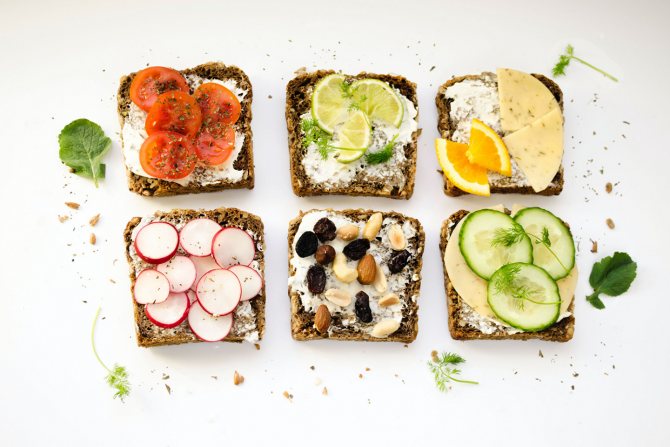
Proper nutrition involves eating whole foods, which make up 80-90% of the diet. They are rich in nutrients and often have low but sufficient calorie content. That is, each serving will provide more benefits without compromising your health and figure. These are necessarily cereals, grains, vegetables, fruits, eggs, meat, fish, dairy products, nuts, oils. For variety, this menu base can be supplemented with optional ingredients: superfoods, spices, sprouts, soy and legume products, berries, seeds. In addition, you need to carefully monitor the sufficient amount of substances if you intentionally exclude certain foods (if you have allergies, vegetarian or vegan diet).
Physical activity for losing excess weight
Even if you exclude harmful foods from the menu that contribute to the accumulation of fatty tissue, you will not be able to cope with those hated kilograms without an active lifestyle.
Before losing excess weight quickly, it is better to go for a medical consultation - only a specialist can recommend physical exercise, taking into account the characteristics of the body or health status. It is not necessary to immediately go to the gym and start working out intensively - such experiments will not lead to anything good
You can discuss a set of classes with a trainer who will help you develop individual exercises aimed at tightening certain parts of the body
It is not necessary to immediately go to the gym and start working out intensively - such experiments will not lead to anything good. You can discuss a set of classes with a trainer who will help you develop individual exercises aimed at tightening certain parts of the body.
It’s better to start with short running, swimming, simple exercises, you can sign up for dancing, yoga. The main condition is that classes must take place at least three times a week. As you continue your workout, drink more fluids - increased activity leads to dehydration of the body, and the burning of fat tissue begins to slow down.
It is recommended to move around more - get to work on foot, take a walk in the fresh air on weekends, take a foray outside the city, into nature. Avoid taking elevators completely - go up stairs only.

Exercises to do at home
If you don’t have time to go to the gym or jog in the morning, you can exercise on your own every day. There are a number of exercises that help you lose weight, shape your figure, and tighten sagging skin.
The “scissors” exercise is perfect for removing fatty tissue from the thighs:
- Take the starting position - lie on your back.
- Raise your legs, bring them together and spread them, making sure that they do not bend at the knees.
- Take the original position and relax for a few seconds.
- Repeat movements 3-6 times.
Squats are another great exercise that allows you to remove fat from your legs, tighten your skin, and strengthen muscle tissue. Squat, paying attention to your posture - your back should remain straight. It is better to spread your legs shoulder width apart.
One of the most effective exercises that intensively affects the abdominal area will help you get rid of belly fat:
- Lie on your back, fix your legs using any support.
- Place your hands behind your head.
- Rise forward with your whole body.
You can alternate with the “oblique press,” when the torso turns in different directions. Do not do this exercise too intensively - start with only 5-10 lifts, otherwise the next day the abdominal area will be very sore, and you will not be able to continue the exercises.
Twisting a hoop is another effective exercise that not only removes fat folds, but also improves the appearance of the abdomen and buttocks. These parts of the body will become toned and acquire seductive shapes.
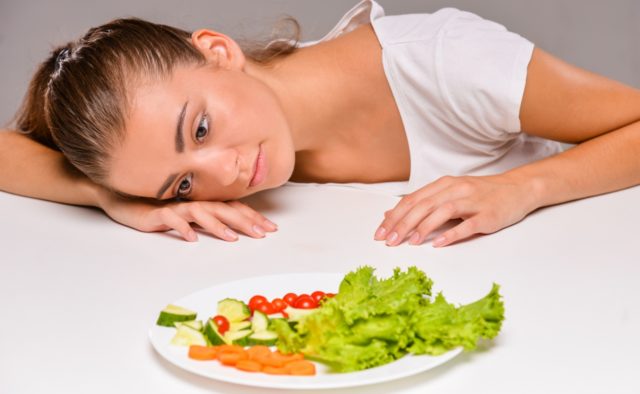
Foods to Avoid
First, let's note that there is no need to eliminate foods forever. Most likely, if you promise yourself to never eat bread again, you will break one day. Allow yourself exceptions from a healthy diet once or twice a week. It is optimal if you eat “unhealthy” foods little by little and after the main balanced meal.
Most processed foods are low in nutritional value and high in calories. Eating well includes avoiding foods containing a lot of sugar most of the time, especially sugary drinks. Doctors associate their consumption with the risk of obesity and type 2 diabetes [11], [12].

Try to avoid trans fats (partially hydrogenated fats), which can cause heart disease [13]. There is also no point in eating processed, refined foods that are high in carbohydrates, such as white bread. They increase the risk of overeating and metabolic disorders [14], [15]. Contrary to popular belief, low-fat foods are also an unhealthy option, as they often contain a lot of sugar and other additives to enhance the taste.
Where to look for healthy fats, proteins and carbohydrates?
Carbohydrates
There are three types of carbohydrates: sugars, fiber, starch. The first include fructose, lactose and sucrose. They are found in dairy products, vegetables, and fruits.
Starch is complex or slowly digestible carbohydrates, the sources of which are grains, legumes, cereals and vegetables. Fiber belongs to the category of indigestible carbohydrates. It is necessary for good functioning of the gastrointestinal tract. Found in vegetables, fruits, nuts, and grains.
Simple carbohydrates or sugars are quickly broken down by the body, increasing blood glucose levels. They give a burst of energy, so they are indispensable during heavy physical or mental stress. However, the rise is followed by a decline. The sugar level decreases, a feeling of hunger occurs and, as a result, the person overeats.
Sources of healthy carbohydrates are:
- Cereals (buckwheat, millet, rice);
- Durum wheat pasta;
- Vegetables, including potatoes;
- Soybeans, peas, beans;
- Fruits and berries;
- Melon crops.
Fats
Fats are an important component of a balanced menu. They provide not only the beauty of skin, hair and nails, but also the health of our cardiovascular system. Vegetable oil, nuts, olives, and sunflower seeds contain healthy fats.
Some types of fish (mackerel, salmon, herring, tuna) are also a source of polyunsaturated fatty acids. A sufficient amount of the right fats in a weight loss diet helps prevent heart attack, atherosclerosis and even cancer.
Daily intake of foods containing fats:
- Seeds, nuts - 30 g;
- Vegetable oils - 2 tsp;
- Fatty fish - 150 g (2 times a week);
- Flax seeds - 2 tsp;
- Olives or black olives - 5 pcs;
The latter should not be used often. These fruits come to us in canned form, so they contain a lot of salt. We should not forget that fat-containing foods are very high in calories, so it will not be possible to absorb them uncontrollably. Proper nutrition involves consuming up to 30 grams of fat per day.
Protein
Protein is the main material for the structure of muscles and nerve fibers. It is actively involved in the metabolic process. Without amino acids in the diet, the supplier of which is protein, the process of healthy weight loss is impossible. And this is not just a matter of cosmetic problems, although wrinkles and sagging skin will also please few people. However, excess protein will also not be beneficial. The required amount of protein is calculated by multiplying body weight by a factor of 0.5. In this case, those losing weight make calculations based on the desired weight.
Sources of complete, easily digestible protein are:
- White meat (chicken, turkey, rabbit);
- Offal (tongue, liver, lung);
- Low-fat fish;
- Chicken and quail eggs;
- Cottage cheese and cheeses;
- Sour cream 10% fat;
- Milk, kefir, fermented baked milk;
- Legumes and soybeans, mushrooms.
Sample menu
A healthy diet is different for everyone. This means that you do not need to follow a clear pattern from the list of dishes, but it is important to learn how to maintain balance yourself and make choices in favor of healthy foods. An approximate menu for the day could be like this:
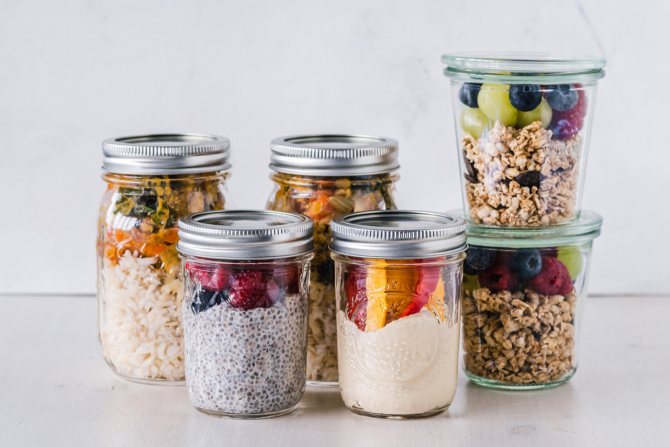
In addition to the composition, it is important to pay attention to the serving sizes. Optimal - 250-350 ml. Whole foods are filling and it's hard to overeat, but with any diet you can develop the habit of eating huge portions. There are several methods of control. For example, start with a smaller portion than usual and increase it if you are still hungry after 20 minutes. Another popular approach is to measure food volume “by eye” using your hand. So, a portion of carbohydrates should be the size of a fist, protein - the size of a palm, and fat - half as much.
Let's start right: a sample menu for a healthy diet
We create a menu taking into account food preferences. It is necessary to determine the calorie content of dishes in advance, and also distribute the planned dishes for the whole week. For example, it is not advisable to combine fish and chicken on the same day.
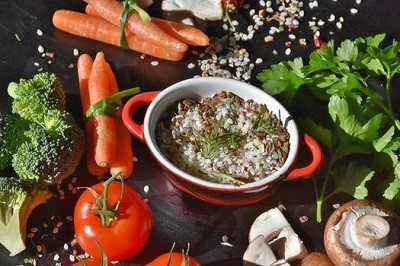
It is also necessary to take into account that 50% of the total calories for the day are due in the morning. And dinner should be light, the portion is small. It is better to drink high-calorie drinks in the first half of the day.
Morning meal:
- porridge from any cereal;
- boiled egg;
- Cup of tea;
- plum or pear.
Snack: choice of sour milk, fruit salad or muesli.
Dinner:
- mushroom soup with cheese;
- schnitzel or kebab with rice;
- cabbage salad with vegetable oil;
- juice.
Snack: choice of cottage cheese with sultanas or 30 g of nuts.
Evening meal:
- hake stewed in cream;
- vegetable stew;
- a cup of green tea.
A pre-set menu increases control and self-discipline.
How to lose weight by eating right
Much depends on the chosen focus in nutrition and previous habits. The effect of switching to a healthy menu is noticeable within the first two to three weeks, if previously highly processed foods or simple carbohydrates often appeared in your diet. For many, adjusting your diet is enough, especially if you have been on strict diets in the past. Eliminating sugar, fried foods and trans fats leads to a decrease in swelling by getting rid of excess fluid in the body.

If you combine proper nutrition with exercise, you will notice positive changes faster. At the same time, it is necessary to monitor the balance of macronutrients, because when there is an excess of energy, the body makes reserves. So, with proper nutrition, you can both normalize and gain weight, if necessary. But, unlike strict mono-diets, it is more of a way of life, adhering to which you can achieve many goals - from improving health to the desired body parameters.
Positive attitude or negative outlook - which works better?
Excess weight originates in our brain, say nutritionists and psychotherapists, and it’s hard to disagree with them. Most people who lose weight have long known that to achieve results you need the right motivation. But, unfortunately, few people have an idea of what it should look like.
By choosing things that we can easily give up as an incentive to lose weight, we are dooming ourselves to failure in advance.
Take, for example, a young lady who is losing weight and dreams of wearing short skirts and tops. The desire to look fashionable and modern in itself is very commendable. But do you think the “mini” will withstand the competition with a piece of the coveted cake or a delicious hamburger? Doubtful.
It’s another matter if the motivation for losing weight is improving relationships with the opposite sex or maintaining health. And if in the first case, proper nutrition and harmony are not always the determining criterion for choice, then in the second, excess weight, without a doubt, entails sad consequences.
Psychiatrists who work with those who want to get rid of excess weight have long practiced shock therapy, frankly telling their patients what awaits them. And there are many “side effects” of being overweight. This is a whole bunch of heart and vascular diseases, high blood pressure, arthritis, arthrosis, osteochondrosis.
With such diagnoses, it doesn’t take long to turn into a disabled person by the age of thirty. Moreover, obesity negatively affects female reproductive function. Simply put, the chubby girl risks never becoming a mother. Now think about it, is it worth ruining your future for the sake of that delicious cake or plate of fried potatoes?
A positive attitude is very important when losing weight. Otherwise, you will either have to give up thinking about losing extra pounds, or you will plunge into depression for the rest of your life. But self-confidence is not always able to serve well. If all the positivity is aimed only at results, you may be able to lose weight, but it is unlikely to remain slim. Indeed, in this case, the person believes that the main goal has been achieved and relaxes.
It’s another matter when proper nutrition and an optimistic attitude accompanies the entire process of losing weight
It is very important in this case to think in the right direction, to understand that a change in eating habits is not a temporary phenomenon. Now it's a new, healthy lifestyle that brings you satisfaction

